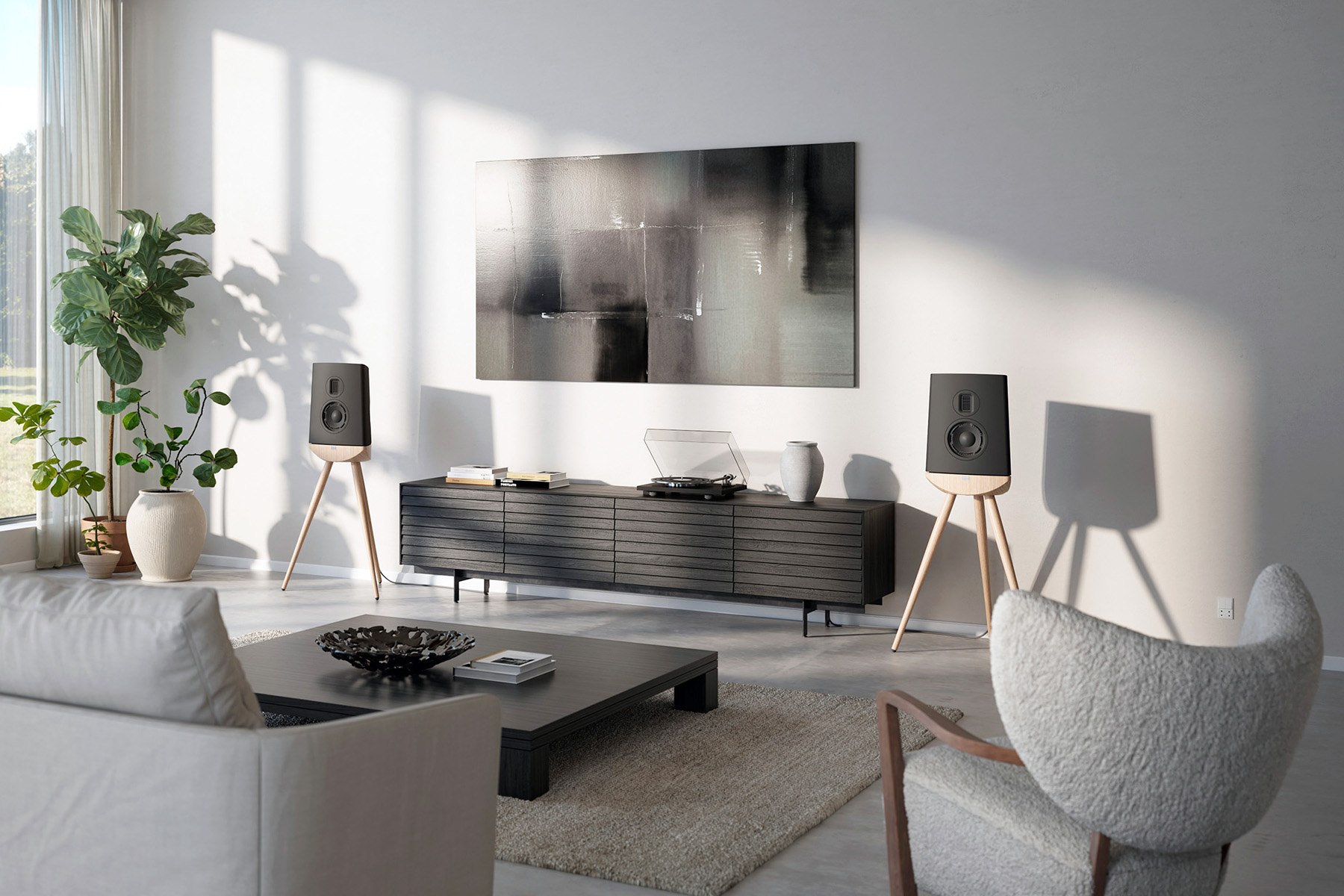
We were delighted to discover the brand new Lyngdorf Cue-100 high-end speaker. An absolute first because the set we listened to at distributor Hifi Corner Trading in Schoten is the first and only one in the Benelux for the time being. This an introduction with high expectations because the Cue-100 is Lyngdorf’s first high-end speaker. This is a milestone in the history of the Danish brand!
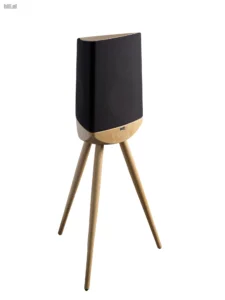
When we talk about Lyngdorf, we first think of the excellent digital amplifiers with which the Danish brand has made its name and fame. This is largely due to the RoomPerfect developed in-house. A highly advanced system that, through specific measurements, not only identifies the sound characteristics of loudspeakers but also takes room acoustics into account. As a result, the sound is perfectly matched to the shape, size and acoustic properties of the listening room.
Lyngdorf: more than amplifiers
Nevertheless, Lyngdorf has also been active in the field of loudspeakers for years. Consider, for example, the Lyngdorf DP-1 speaker with accompanying BW-1 subwoofer and the Lyngdorf MH-3 and MH-2 satellite speakers with their Lyngdorf BW-3 and BW-2 subwoofers. Then there are the FR-1, CS-1 and CS-2 full-range in-cabinet speakers and custom installed speakers with the LS-1000 system for the home theatre as the figurehead. In short, there is no shortage of loudspeaker systems among the Danes. Now there is the brand new Lyngdorf Cue-100 high-end speaker.
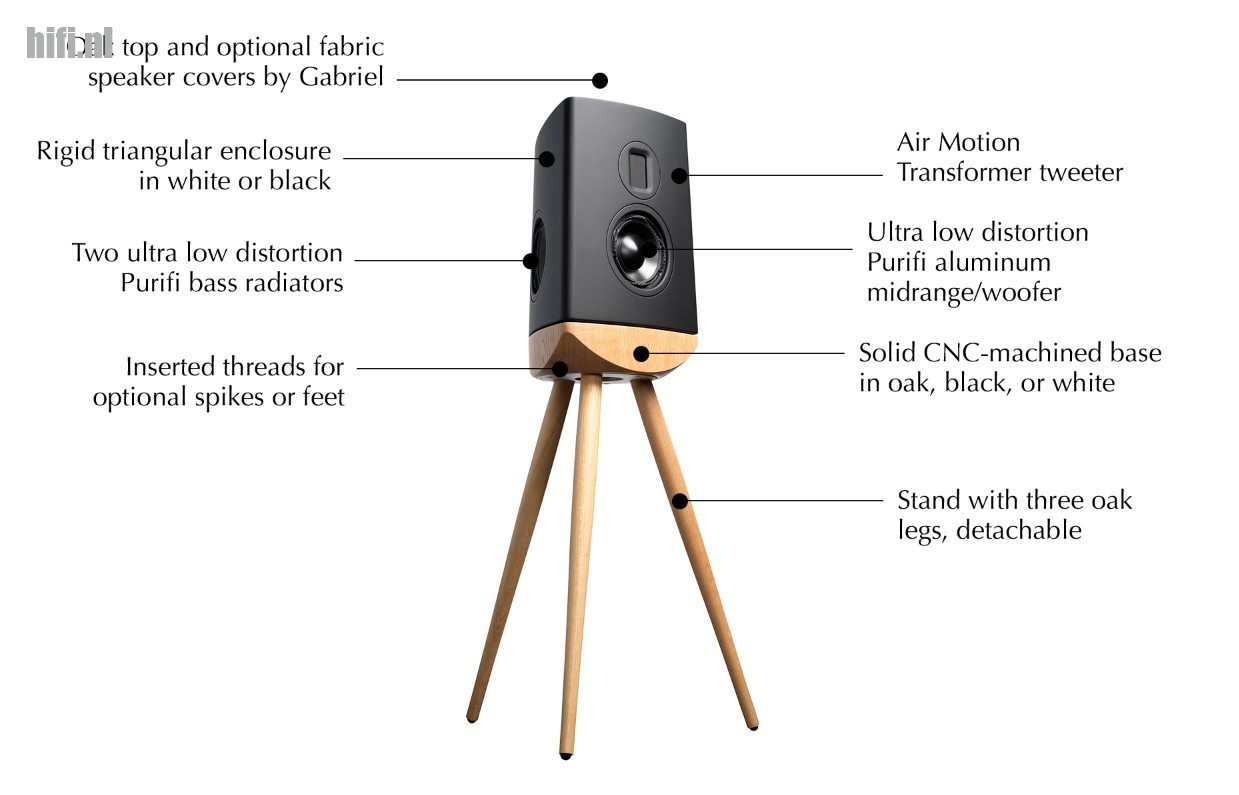
The Cue-100 is Lyngdorf’s first high-end loudspeaker, a more than successful combination of Scandinavian design with the latest loudspeaker technology. Designed and built in Denmark to appeal to both audiophile music lovers and music lovers with an eye for design.
Lyngdorf Cue-100 high-end speaker: the most expensive Lyngdorf ever
“With the Cue-100, Lyngdorf creates a new category and price range,” explains Willy Van de Velde of Hifi Corner Trading (photo below). “The Cue-100 is the most expensive speaker Lyngdorf ever made. It is the brand’s first full-range speaker that does not require an accompanying, separate subwoofer. Although it is, of course, perfectly possible to add a subwoofer if desired to achieve the maximum sound pressure.”

“Since that woofer does not cause distortion, can handle 250 watts, with an efficiency of 83 db, you can pump a lot of power into it. So if we connect a Lyngdorf TDA-I 3400 amplifier of 200 watts to it, which at 4 ohms can deliver no less than 400 watts, you can achieve an enormous noise level,” he laughs.
Scandinavian design
The Lyngdorf Cue-100’s remarkable housing has a triangular shape and is made up of three tapered and slightly rounded sides made from 35 mm thick CNC-machined MDF. This not only reduces resonance and internal standing waves to a minimum, it gives the speaker a slim and stylish appearance, a textbook example of Scandinavian design.
On the side of the housing are two passive woofers instead of classic bass pipes that reduce the resonance frequency to create a deeper bass. They are purely acoustically driven by the front woofer.
The Cue-100 rests on a specially designed stand in solid oak or MDF that adds extra rigidity to the whole. With four different cabinet combinations and five different optional fabric covers, the Cue-100 is available in no fewer than 24 color combinations. This allows it to be perfectly adapted to any interior in which it ends up.

Purifi speaker technology
The Lyngdorf Cue-100 uses Purifi loudspeaker technology. Purifi , the Danish company around Peter Lyngdorf, Lars Risbo and Bruno Putzeys, developed a brand new measuring instrument to test speakers. Willy: “Because this measuring instrument can detect deformations never measured before, the Purifi engineers discovered some points for improvement. As a result, the new woofer delivers virtually distortion-free performance.”
 With the so-called ‘Neutral Surround Geometry’ of this aluminum cone midrange/woofer, copper clad fibreglass based voice coil and moulded vented basket, Purifi sets new standards in loudspeaker technology. The ring shape of the midrange/woofer consists of ‘alternating mountain ridges’, as they call it at Purifi. “In plain language, a woofer with an apparently frayed edge,” explains Willy. “The advantage of this design is that the edges of the woofer move outwards and inwards equally with each movement. This results in a long and even stroke and ultra-low distortion.”
With the so-called ‘Neutral Surround Geometry’ of this aluminum cone midrange/woofer, copper clad fibreglass based voice coil and moulded vented basket, Purifi sets new standards in loudspeaker technology. The ring shape of the midrange/woofer consists of ‘alternating mountain ridges’, as they call it at Purifi. “In plain language, a woofer with an apparently frayed edge,” explains Willy. “The advantage of this design is that the edges of the woofer move outwards and inwards equally with each movement. This results in a long and even stroke and ultra-low distortion.”
Air Motion Transformer
The tweeter in the Cue-100, or rather the ‘Air Motion Transformer’, is an electromagnetic driver that moves the air in the harmonica-shaped construction suspended between two powerful magnets. The vertical pumping motion of the structure moves a much faster airflow than that of a traditional tweeter. Due to the tight control of the magnetic field, the chance of distortion is again a lot smaller.
In short, thanks to the special midrange/woofer and tweeter, you can play very loud with the Lyngdorf Cue-100 without distortion occurring. Although, of course, we recommend not to do any violence to your ears.
We listen to the Lyngdorf Cue-100 in the auditorium of Hifi Corner in Schoten. The Cue-100 speakers are powered by a Lyngdorf TDAI-3400 amp with a built-in music streamer and a Lyngdorf CD-2 CD drive. The cabling is from AudioQuest.
Willy Van de Velde starts the listening test with ‘1980 14 (Dorro Remix)’ by Affani and turns up the volume considerably. “Tomorrowland in Schoten”, shout two sixty-somethings who surrender to the heavy beats to confirm experimentally that the Lyngdorf Cue-100 is effectively able to build up great sound pressure and blow your socks off. But perfectly timed and with maximum control.
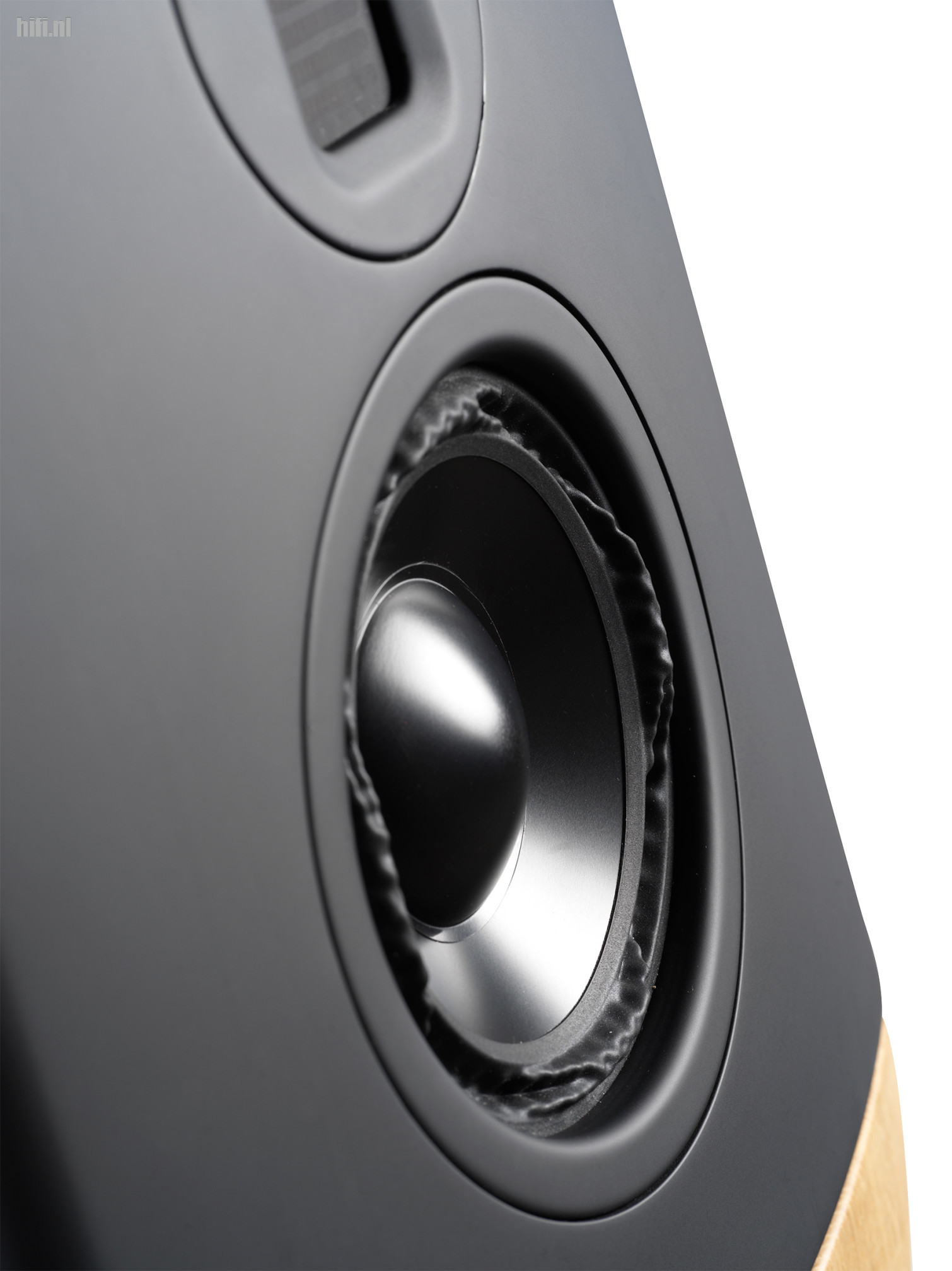
Brothers in arms
To avoid this being our last joint listening test due to sudden deafness, we lower the volume to a respectable living room level and let ourselves be seduced by Chantal Chamberland’s ‘Beautiful Life’. We experience excellent sound clarity. Chamberland’s voice, accompanied by a sparkling fresh piano and perfectly controlled bass guitar, provides an instant, relaxed feeling.
That feeling is perpetuated with ‘Brothers in Arms’, a beautiful cover by Club for Five. The deep baritone of lead singer Juha Viitala, accompanied by the fragile backing choir and a cellar-deep bass, forms a rich, harmonic whole.
A dash of Keb’ Mo’ with an organ tune, piano and blues guitar on ‘The Itch’ brings us into a melodic daze. Not least because of the enormous detail that makes it easy to visualize the band members of Keb’ Mo’ but also because of the special spatial sound image that the Lyngdorfs sketch. ‘Thanks to You’, a frequently played track on audio shows because of the basement-deep bass line that makes many speakers go wrong, doesn’t stand a chance of unnerving the Cue-100.

‘Liberty’ by Anette Askvik, which is also one of the most popular show tracks, provides the goosebumps moment of the day. We’ve heard this song so many times, but today we discover details in it that we didn’t notice until then. Especially when the sax and percussion come in, it becomes even more clear that the Cue-100 offers an accurate and rich music reproduction.
To each his own
Of course, we reviewed a lot of music. We have not even shied away from André Hazes. Just to show that all types of music deserve to be played in the best possible conditions. And that’s exactly what the Lyndorf Cue-100 does.
After an extremely relaxing listening test, we return with our feet on the ground. There is one more important question in the back of our minds. A Lyngdorf high-end speaker with a price tag of € 20,000 per pair, isn’t that a slight form of cannibalism compared to Steinway-Lyngdorf, we wonder? “Certainly not”, says Willy Van de Velde. “Steinway’s Model O is the closest thing to the Lyngdorf Cue-100. It also has a passive woofer at the back and uses the same tweeter. But don’t forget that the cost to build the Model O and the level of finish is higher. Moreover, you cannot buy the Model O without the accompanying Steinway-Lyngdorf processor because the Model O does not have a crossover on board.”
“All Lyngdorf amplifiers can drive the Cue-100 without any problems. From the smallest TDAI-1120 with its unbeatable price-quality ratio to the TDAI-3400 that has Steinway-Lyndorf output stages on board. Let’s just say that the Lyngdorf Cue-100 100 and the Steinway-Lyngdorf are in line with each other”, he laughs. Lyngdorf’s first high-end speaker has a hefty price tag that leans towards Steinway Lyngdorf, the nec plus ultra from Peter Lyngdorf’s Lyngdorf dynasty. rightly so, because the Cue-100 performs at a very high level, a level where the Cue-100 effortlessly outperforms quite a few competitors, and then the price tag even gets interesting.
Conclusion
With its beautiful, pronounced Scandinavian design, the Lyngdorf Cue-100 looks completely different from all other Lyngdorf speakers. The Cue-100 is a feast for the eyes that literally and figuratively fits into any interior. However, some Lyngdorf adepts will have to turn a button.
The Cue-100 is also a feast for the ears. A speaker that is easy to control. Especially in combination with a Lyngdorf amplifier with RoomPerfect technology, you can play like a charm. Anyone who takes the trouble to listen to the Cue-100 in detail can only conclude that the Danes have set a milestone in the history of the brand with this particularly musical speaker. Never before have we been blown away by a Lyngdorf system in such a relaxed way. Please take that from us.
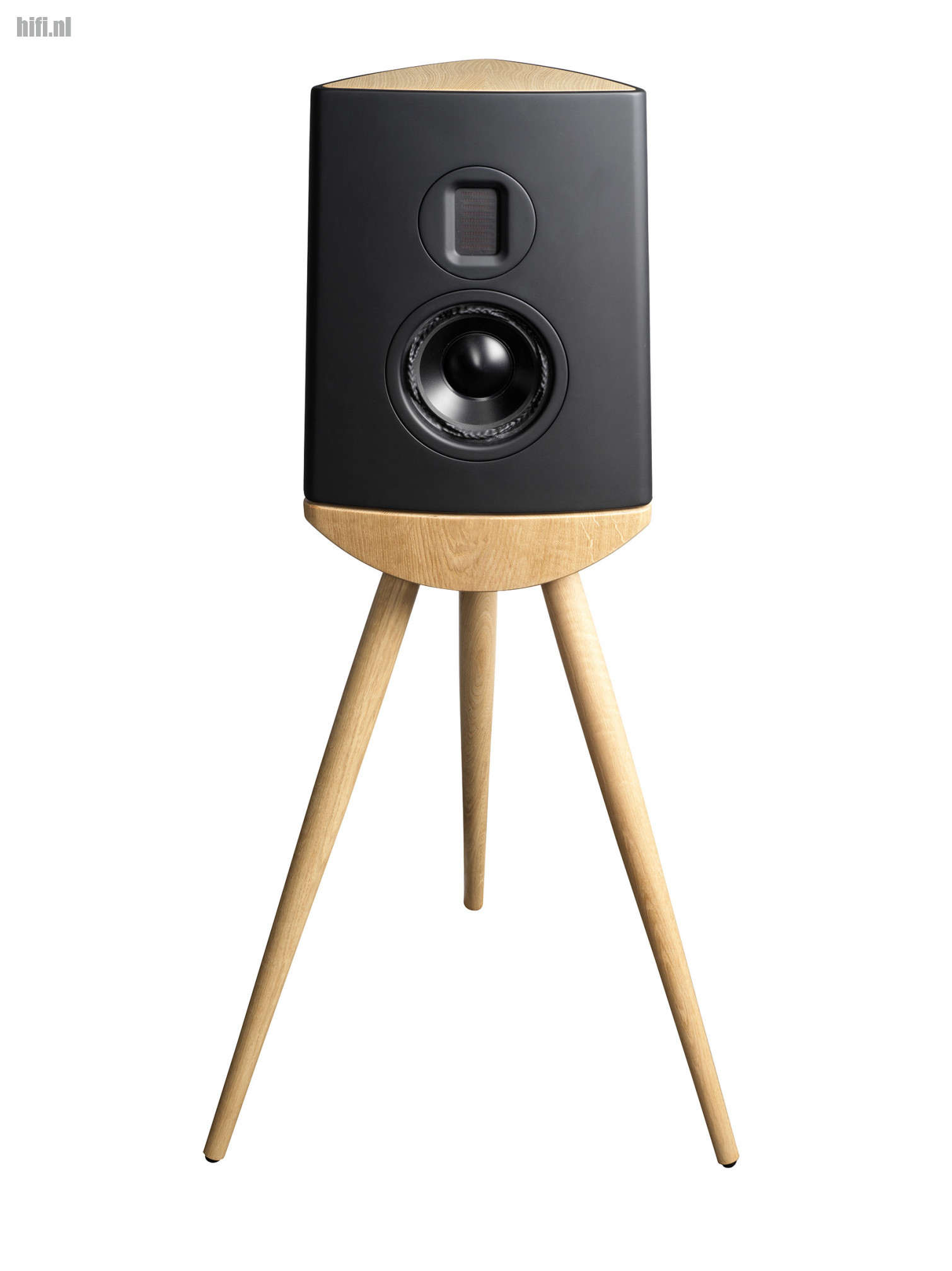
Find out more about the Lyngdorf Cue-100 on the manufacturer’s website.
Specifications:
Description: speaker on stand
Power: 250 W
Tweeter: Air Motion Transformer, Kapton foil, Neodymium magnet
Midrange/woofer: 16.5 cm / 6.5-inch aluminum cone, 39 mm 4-layer copper-clad aluminum fibreglass-based voice coil, neutral edge geometry, die-cast vented basket
Woofer: 2 x 16.5 cm / 6.5-inch passive radiator, aluminum cone, neutral edge geometry, die-cast vented basket
Enclosure: MDF, oak
Frequency response: 35 – 22,000 Hz (-3 dB)
Nominal impedance: 4 Ohm
Sensitivity: 83 dB 2.83 v/1 m
Frequency: 2300 Hz
Connections: Gold-plated speaker terminals
Recommended placement: On tripod (included)
Dimensions (W x H x D): 350 x 513 x 329 mm /13.8 x 20.2 x 13 inches
597 x 1196 x 520 mm (including stand)
Weight: 13.8 kg / 30.4 lbs – 16, 2 kg (including base)
Standard finishes: white/oak base, black/oak base, white/white base, black/black base, legs in oak, optional fabric cover in different colors

